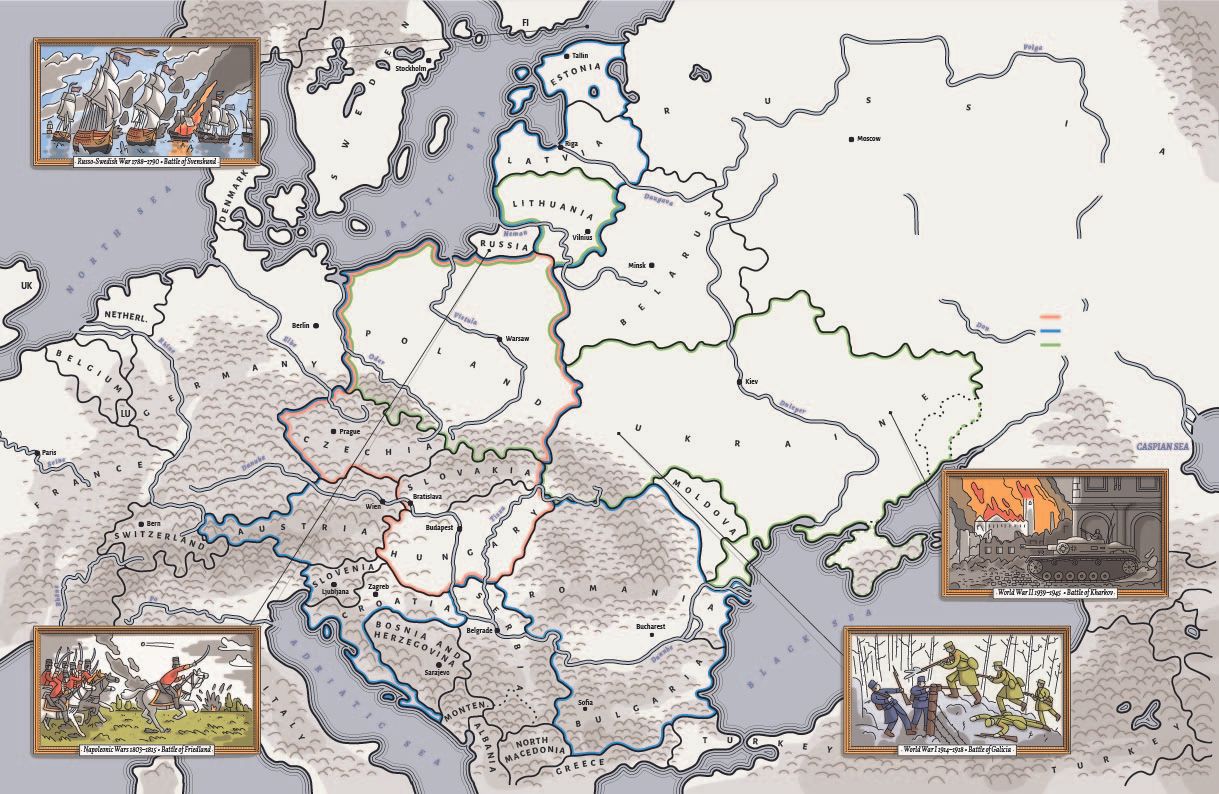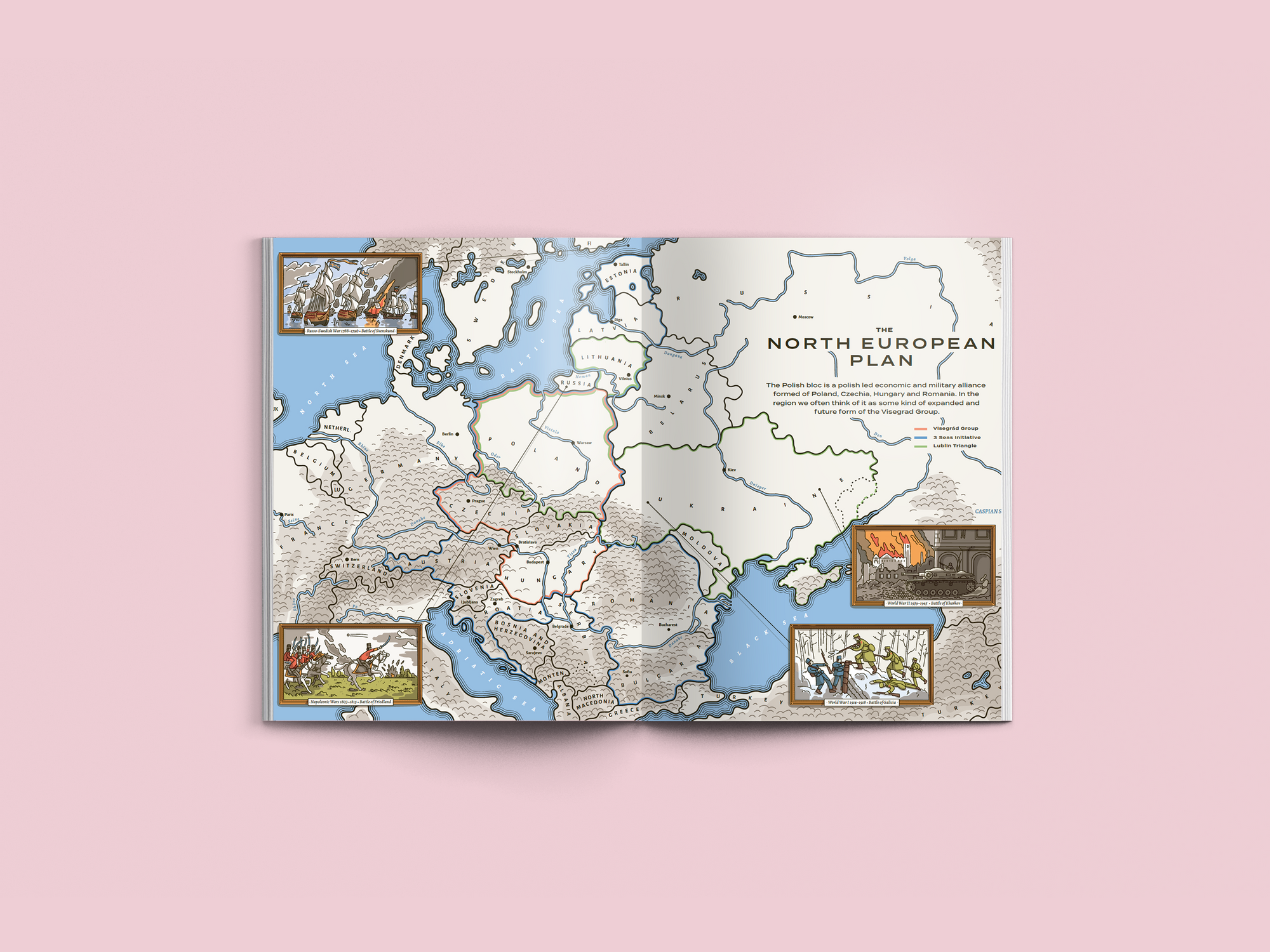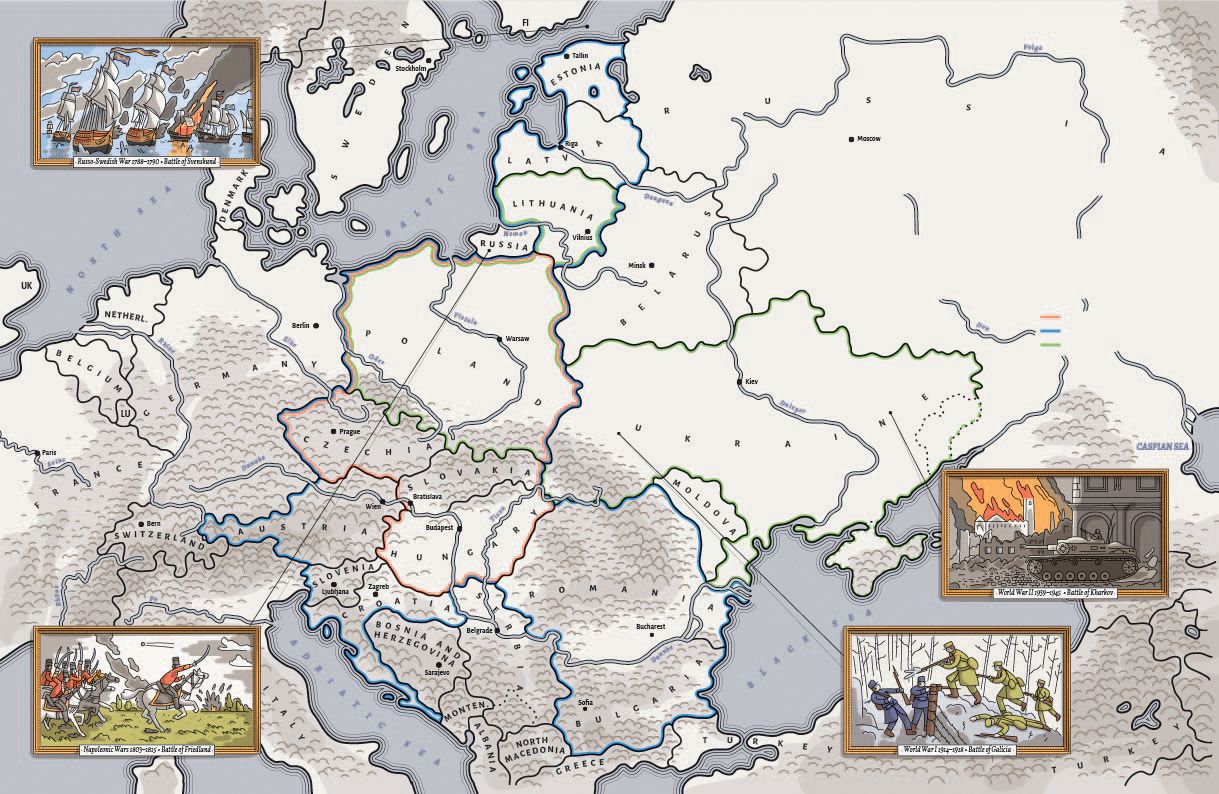We asked George Friedman to provide an interpretive framework for understanding the overall strategic situation in Eastern and Central Europe. In recent decades, his writing has predicted the challenges and opportunities of the coming periods with striking accuracy, so his thoughts are worth taking seriously and incorporating into our thinking when reading about geopolitics or international events. This article was published in print in Hype&Hyper 2021/1.
The Polish Bloc
The Polish Bloc, as it is being called, occupies the North European plain, a plain that runs from the Atlantic coast and eastward through Northern Europe to Moscow. All major European wars in over three centuries have been fought primarily, if not exclusively, on this plain. This includes the Russo-Swedish War, the Napoleonic Wars, World War I and World War II. The Cold War was a confrontation between NATO and the Warsaw Pact, that never spilled over into a hot war. This plain is where Europe’s fate is constantly decided, whether through victory or stalemate.
Major systemic wars involving the plain are infrequent but regular events. They take place once or twice a century, and their outcome redefines Europe and even the world. In World War II, it ended in the subjugation of Poland, Hungary and Czechoslovakia by Germany and previously, in the First World War, the Germans drove through the plain resulting in a communist Russia. Whenever there is a systematic European war, it has pitted a Western European power against Russia, with massive consequences for the Polish Bloc during and after the war.

The term “Polish bloc”, used by George Friedman, refers to a Central European alliance led by Poland because of its economic weight and size, and with the Czech Republic and Hungary as its members. It refers not as an institutionalised alliance, but as a geopolitical phenomenon. The closest institutionalised form to this is the Visegrad Cooperation, but at the same time, under Polish leadership, several other similar inter-European organisations are taking shape, such as the Three Seas Initiative or the Lublin Triangle.
The problem of the third power guarantee
The strategy of the Bloc has been driven by the realistic perception that they could not resist the strength of an Eastern or Western power. Their solution has been to seek alliances and guarantees from other European powers. The weakness of this strategy was that the guarantees, when given, could rarely be fulfilled. The guaranteeing power was too far away, lacking interest in the North European plain in spite of guarantees or being themselves involved or preparing for major conflict. As a result, the strategy of The Polish Bloc in seeking third power guarantees has rarely resulted in the deployment of forces in position to protect the Polish Bloc.
Any defense of the region predicated on the intervention of major powers will fail historically. When a systemic war breaks out in Europe, the Northern European plain is always a strategic region, but Europe is a small place, and the likelihood that the time in which allies are most needed, is the time at which they are most preoccupied by their own national security interest.
This then leaves the region with three choices. The first is to ally with one of the main powers, such as the Hungarians aligning with Germany in World War II. The problem is that should it select the losing ally, it will share its face in defeat. A second strategy is to hope that this war will not be fought on the Plain. Except for minor wars in Iberia, Italy or the Balkans, this would never be the case. The war will come to them. The third choice is to form a military bloc that creates sufficient force to shape the war.
In a war between a Western and Eastern power, no single nation in the Polish Bloc can possibly mount significant defense against either attacking power, let alone both. In such a war, each country will be separately or together occupied or worse, as in much of World War I, some will become a battleground, which would be catastrophic even if a degree of sovereignty could be retained. No single nation has the ability to force attacking powers to avoid the region.
The Swiss Strategy
The Polish Bloc’s only viable strategy is war avoidance. This does not mean collaboration or capitulation: it means the Swiss strategy. During both World War I and II, Switzerland, in spite of being an attractive highway for flanking attack or logistics support, was never attacked or occupied. The answer for this is that its terrain made passage impossible. It increased the difficulty but movement through Switzerland was far from impossible, particularly by a power temporarily in a position where the enemy could not insert forces to hold mountain passes or other key positions. The Germans in 1941 or the Americans in 1944 could pass through Switzerland without major fear that an outside blocking force would be deployed. It is frequently said that no attack was made by Germany or the United States because both relied on the Swiss banking system. The dependence was there, but it was not sufficient to prevent taking the strategic territory of Switzerland.
The answer lies in the Swiss Defense Strategy. Switzerland itself had armed the population, mined key passes and so on. They have had this strategy in place for a very long time. Its goal is not to defeat an enemy like Germany or the United States. Rather it was, in the words of Charles De Gaulle, to tear an arm off of anyone who attacked. The strategy was designed to give the potential attacker reason to fear that an attack on Switzerland would divert men and material badly needed for the main thrust, and that Switzerland would impose a time penalty that would disrupt their war plan and create delays and weakness that the main enemy might take advantage of.
The Swiss strategy assumes that the enemy (and friends) have the ability to defeat Swiss forces. While successful defense is impossible, Switzerland was aware that the threat to the nation would occur at a time where major powers were engaged in combat outside of Switzerland, and that any action in Switzerland would be considered in the context of the major war. If Switzerland had sufficient force to impose penalties on intruders, then the potential impact on the major area of combat would be sufficiently great or at least sufficiently uncertain to cause them to decline an intrusion into Switzerland. The time and material costs would outweigh the benefits of any potential flanking opportunity. Switzerland wasn’t attacked because the potential cost outweighed the advantage.
The Polish Bloc must consider the Swiss strategy very carefully in my view. Obviously, the terrain on the Northern Plain offers no opportunities for a force multiplier. However, creating artificial barriers robust enough to resist air or missile attacks, extremely difficult for armor or armored infantry to cross, and strategically and generously distributed would provide a degree of equivalency. But as I said in the case of Switzerland, the terrain was a consideration but not by itself decisive. Swiss defense forces, strengthened by the terrain, were the key.
Switzerland operated on the principle of universal military training, allowing trainees to return to their lives, carrying home weapons on which they were well trained. There was a small cadre of professional soldiers, charged with managing the battle, but the main force consisted of regional formations of citizens. This regionalism, I believe, strengthened the will and unit integrity of the Swiss. Switzerland had well-trained and armed population protecting their homes and families. Arming and training the entire population in defense of their homes made Switzerland much stronger than it appeared.
Applying this model to the North European plain would require profuse blocking systems coupled with the Swiss concept of manpower training and deployment. The Swiss also never used its force outside the country. If war would come, it was coming at home. This avoided the inherent problem of a population distrusting the politicians who might be squandering lives outside the country. Fighting would happen only when the enemy arrived, or when an enemy arrived so close, to another member of the Bloc, that the need was obvious. Trust, as I said before, is essential and will derive from a reality understandable by those who would fight for their families.
The key is common interest
The geopolitical center of this concept would be the unity of the members of the Bloc. In World War II, the Bloc manifested all the weakness of its position, while thinking themselves clever. The Czechs and Poles had agreements with major powers that were not honored and had anyone looked at a map, could not have been honored. The Hungarians sought safety in complex, multi-layer diplomacy that bought them time, and having no way to use the time, allowed German occupation. The Germans and Russians wanted the Polish Bloc out of the way, each for their own reasons. The Polish Bloc lacking any understanding of their common interest, ended in disaster.
A war is always lurking in the future of Europe. It is impossible to tell when and about who, but we can be certain it will happen. When the war looms, the desperate diplomacy will be seen as a sad alternative to preparedness. The claim that the Bloc is too weak to protect its interest is now, as then, a comforting justification for not preparing. The most important problem is geographic. Each country by itself is either too small or lacking in defensible terrain. The three countries of the Block together are sufficient for a Swiss strategy, where a Western and Eastern power decide to take the main stage of the war elsewhere. Unity is an absolute reality, and alliance on the eve of war is pointless. The three countries must work and train. If they do this, they can deny the Northern plain to the enemy by turning it from flat and seductive to complex and difficult. In that case, outside powers will have time to involve themselves, they will be joining a fighting force, rather than a hopeless cause. Then maybe the history of warlike Europe can have its course changed.

Born in Budapest on February 1, 1949, George Friedman emigrated to the United States with his parents, fleeing communism at the age of one, and by now, he has become the world’s best-known geopolitical analyst and advisor. He is the author of countless bestsellers, and his captivating performances allow us to look into the events of the future with astonishing realism. His most popular book, the “The Next 100 Years” proves the accuracy of his views over and over again. His books have been translated into more than twenty languages. Dr. Friedman has advised several governmental and military organizations in the United States and their allied countries.

Prefer to read it in print? Order the first issue of Hype&Hyper magazine from our online Store!

The Jewish Museum Berlin opens a new playground, suitable for children and adults alike

An eco-park combining local needs and green aspects at the heart of Vizafogó, Budapest










